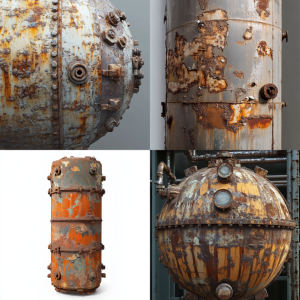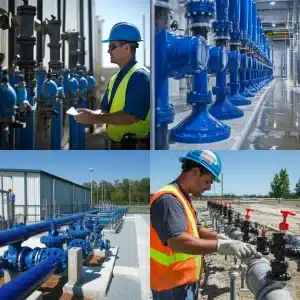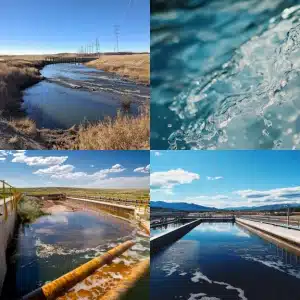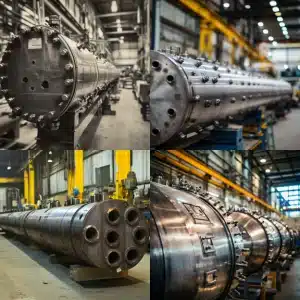Common Water Pressure Vessel Failures in Applications

Understanding and Preventing Critical Pressure Vessel Failures in Water Applications
Water pressure vessel failures in water applications pose serious risks including system shutdowns, contamination, and catastrophic ruptures. The most common water pressure vessel failures in water applications result from corrosion, fatigue cracking, manufacturing defects, over-pressurization, and seal degradation.
To prevent water pressure vessel failures, implement regular inspection protocols including monthly visual checks and annual thickness measurements. Choose appropriate materials like stainless steel 316L for chlorinated water or FRP for highly corrosive environments. Water pressure vessel failures in water applications can be mitigated through proper pressure relief systems with redundant valves and monitoring capabilities.
Following ASME standards ensures vessels meet rigorous safety requirements. Partner with certified manufacturers like Red River for quality fabrication and proper installation.
Preventive maintenance costs significantly less than addressing water pressure vessel failures in water applications after they occur. By addressing potential issues early through proper material selection, regular inspections, and adherence to industry standards, you can extend vessel lifespan and maintain safe, efficient water treatment operations.
Most Common Pressure Vessel Failures in Water Applications
1. Corrosion and Rust
Corrosion remains the leading cause of water pressure vessel failures in water applications. Internal corrosion typically results from untreated or improperly balanced water, high chloride content, and low pH levels. External corrosion stems from environmental humidity, water leaks, and inadequate protective coatings.
As corrosion progresses, vessel walls thin and eventually compromise structural integrity. In carbon steel vessels, wall loss can occur at rates of 0.1-0.5mm per year in aggressive environments. Additionally, rust particles can contaminate water supplies, affecting quality and downstream equipment performance. Advanced corrosion creates pinhole leaks that worsen into larger water pressure vessel failures if left unaddressed.
Different water chemistries produce varying corrosion mechanisms. Chloride-rich environments cause pitting corrosion, while low-pH waters promote uniform thinning. Understanding these specific interactions helps in selecting appropriate materials and protective measures to prevent water pressure vessel failures.
The economic impact of corrosion-related water pressure vessel failures in water applications extends beyond replacement costs. Contaminated water, system downtime, and potential regulatory violations all add to the total cost of failure.
2. Fatigue and Stress Cracking
Water pressure vessel failures in water applications often result from fatigue, especially in systems with pressure fluctuations. Repeated expansion and contraction cycles create microscopic cracks, typically originating at weld joints or stress concentration points. Without detection, these cracks propagate until catastrophic water pressure vessel failures occur.
Municipal water systems with frequent pressure changes are particularly vulnerable to water pressure vessel failures from fatigue. These cracks may remain invisible during routine inspections until they reach critical size. Cycle counters and pressure monitoring help quantify fatigue exposure and anticipate potential water pressure vessel failures before they occur.
Thermal cycling compounds this issue, especially in hot water applications where temperature variations cause additional stress. The interface between different materials with varying expansion rates creates particularly vulnerable areas prone to water pressure vessel failures.
Stress corrosion cracking (SCC) represents a dangerous combination of mechanical stress and corrosive environments. In chloride-rich waters, even stainless steel vessels can experience SCC, leading to water pressure vessel failures, especially at elevated temperatures.
3. Manufacturing Defects
Improper welds and fabrication issues contribute significantly to water pressure vessel failures. Common manufacturing defects include incomplete weld penetration, porosity, slag inclusion, and misalignment. These flaws create weak points that deteriorate under operating conditions.
ASME certification ensures proper inspection and testing. Non-destructive examination methods like radiographic testing, ultrasonic inspection, and dye penetrant testing identify hidden defects. Vessels with complex geometries require particular attention due to higher stress concentrations. Proper documentation of manufacturing processes provides valuable reference information for preventing future water pressure vessel failures.
4. Over-Pressurization
One of the most dangerous water pressure vessel failures is over-pressurization from pump malfunctions, failed relief valves, blocked discharge lines, or operational errors. Without adequate safety systems, pressure spikes cause violent ruptures with severe consequences.
High-pressure systems require properly sized relief valves and pressure monitoring. Digital monitoring with automated shutdown provides additional protection. Water hammer effects from sudden valve closures create pressure surges, particularly in long pipe runs. Surge tanks and slow-closing valves mitigate these risks.
Industry statistics show over-pressurization accounts for 25% of catastrophic water pressure vessel failures, highlighting robust pressure management importance.
5. Seal and Gasket Failures
Compromised sealing components frequently lead to water pressure vessel failures. Temperature fluctuations, chemical exposure, and improper installation contribute to seal degradation. Failed seals cause water leakage, pressure loss, and system contamination that escalate to major failures.
While less catastrophic than ruptures, persistent seal failures cause significant water damage, energy loss, and operational disruptions. Selecting appropriate sealing materials compatible with specific water chemistry extends service life and reduces water pressure vessel failures.
Prevention Strategies for Pressure Vessel Failures in Water Applications
Regular Maintenance and Inspections
Systematic inspection protocols prevent pressure vessel failures in water applications. A comprehensive program should include monthly visual inspections, quarterly pressure testing, and annual ultrasonic thickness measurements.
Early detection through these measures significantly reduces failure risks and extends vessel lifespan. Learn more about our capabilities in pressure vessel maintenance.
Documentation of inspection findings creates a historical record that helps identify degradation patterns before they become critical. Technicians should be trained to recognize early warning signs of the various failure modes.
Material Selection for Water Applications
Choosing appropriate materials prevents pressure vessel failures in water applications. Stainless steel 316L works well for chlorinated or brackish water, while fiberglass-reinforced plastic (FRP) excels in corrosive environments. Epoxy-lined carbon steel offers cost-effective protection for many applications.
Material selection must align with specific water chemistry, pH levels, and operating temperatures. Our pressure vessels are manufactured with optimal materials for each specific application.
The initial cost of corrosion-resistant materials is typically offset by extended service life and reduced maintenance requirements.
Implementing Pressure Relief Systems
Effective pressure control prevents catastrophic pressure vessel failures in water applications. Key components include redundant pressure relief valves, rupture discs at strategic locations, and digital pressure monitoring systems.
These safeguards provide critical protection against over-pressurization events. Our pulsation dampeners can also help manage pressure fluctuations in water systems.
Modern systems incorporate automated alerts that notify operators of abnormal pressure conditions before they reach critical levels, allowing for preventive action.
Adhering to ASME and Industry Standards
Compliance with established codes prevents pressure vessel failures in water applications. ASME Section VIII establishes design parameters, while certified fabrication processes and documented testing procedures ensure quality construction.
Working with ASME-certified manufacturers ensures vessels meet rigorous safety and performance standards. Learn about our commitment to quality through our solutions page.
Regulatory compliance isn’t just about legal requirements—it represents decades of engineering knowledge developed to prevent failures and protect users.
Final Thoughts
Pressure vessel failures in water applications are largely preventable through proper understanding of failure mechanisms and implementation of preventive measures. By addressing corrosion, fatigue, manufacturing quality, pressure control, and material selection, operators can significantly reduce failure risks.
Investing in quality materials, regular maintenance, and partnerships with reputable manufacturers ensures both safety and long-term performance of pressure vessels in water applications. For comprehensive pressure vessel solutions, contact us or request a quote.
The cost of prevention is invariably lower than the cost of failure, making proactive maintenance and quality equipment essential for water treatment systems.
Preventing Pressure Vessel Failures in Water Applications
Pressure vessel failures in water applications can be prevented through regular inspections, appropriate material selection, and robust pressure management systems. Following ASME standards and implementing preventive maintenance significantly reduces risks. The investment in prevention is always less costly than addressing failures after they occur.
Need a reliable partner?
Red River specializes in the design and manufacturing of pressure vessels. We also fabricate related items such as prefabricated spools and skid packages.
Reach out to us today and experience the Red River difference. Where American-made products and American Values come together, we care more.
Frequently Asked Questions
1. What signs indicate potential pressure vessel failures in water applications?
Look for visible corrosion, external leaks, unusual noises, pressure fluctuations, and valve malfunctions.
2. How frequently should water system pressure vessels be inspected?
Conduct visual inspections monthly, pressure tests quarterly, and comprehensive evaluations annually.
3. Can pressure vessels that have experienced partial failures in water applications be repaired?
Minor issues like surface corrosion may be repairable, but significant damage typically requires vessel replacement.
4. What materials best resist pressure vessel failures in water applications?
Stainless steel 316L, FRP, and properly lined carbon steel offer excellent corrosion resistance for water applications.
5. What standards govern prevention of pressure vessel failures in water applications?
The ASME Boiler and Pressure Vessel Code provides comprehensive guidelines for design, manufacturing, and testing.
Key Takeaways
- Water pressure vessel failures in water applications most commonly result from corrosion, fatigue, manufacturing defects, and over-pressurization
- Regular inspection protocols significantly reduce water pressure vessel failures risks
- Material selection must align with specific water chemistry and operating conditions to prevent water pressure vessel failures
- ASME certification ensures vessels meet rigorous safety standards and resist water pressure vessel failures
- Partnering with experienced manufacturers like Red River provides long-term reliability in preventing water pressure vessel failures in water applications.




